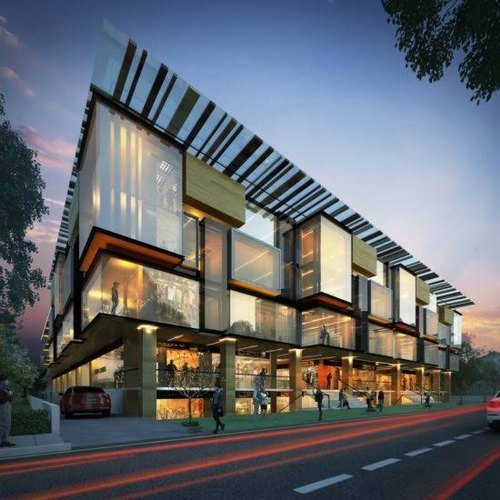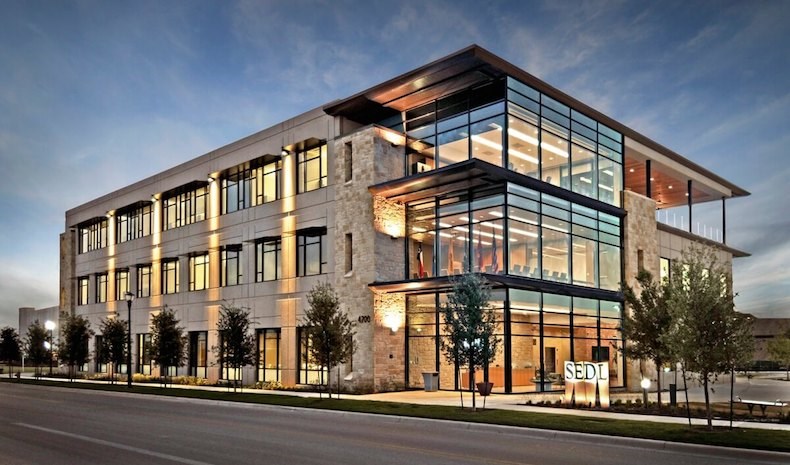Unveiling the Comprehensive Solutions Given by Commercial Architects for Modern Advancement
Commercial Architects serve a critical function in contemporary growth projects. They blend design aesthetic appeals with capability while sticking to regulative demands. Their proficiency prolongs beyond simple building and construction, incorporating sustainable techniques and innovative technologies. As they navigate complicated zoning legislations, Architects collaborate with various stakeholders to bring visions to life. This multifaceted approach raises concerns about the developing duty of Architects fit modern rooms and the impact of their work on future advancements.
Comprehending the Role of Commercial Architects in Modern Advancement
In contemporary urban landscapes, Commercial Architects play a crucial role in shaping useful and aesthetic rooms that satisfy varied company needs. Their proficiency expands beyond mere design; they navigate complicated zoning legislations, constructing codes, and environmental policies. By working together with customers, they recognize specific needs, making certain that each task straightens with the customer's vision while likewise thinking about sensible aspects such as sustainability and cost-effectiveness. Commercial Architects are skilled at incorporating ingenious technologies and materials into their designs, boosting both the capability and power effectiveness of structures. They carry out complete website evaluations to evaluate the potential obstacles and chances offered by an area. In addition, reliable interaction with professionals and other stakeholders is necessary, guaranteeing that the task advances efficiently from perception to completion. Inevitably, Commercial Architects contribute in creating spaces that not just satisfy functional purposes however also add to the general character and vibrancy of metropolitan environments.
Principle Design: Transforming Ideas Into Fact
Concept style works as a necessary phase in Commercial design, where cutting-edge style services arise from innovative brainstorming. This process counts on joint ideation, bringing with each other varied point of views to refine and enhance preliminary concepts. As ideas form, they transform from abstract ideas into substantial architectural facts.
Ingenious Style Solutions
Transforming ideas into truth is the trademark of ingenious style remedies in Commercial style. These remedies mix imagination with capability, dealing with the one-of-a-kind requirements of contemporary advancements. By leveraging innovative modern technologies and lasting techniques, Architects craft rooms that are not just aesthetically enticing but likewise efficient and adaptable. Focus on customer experience drives the layout procedure, making sure that atmospheres foster productivity and collaboration. Each job take advantage of a tailored method, where ideas are diligently created to reflect the customer's vision while taking into consideration future patterns. Ingenious style options likewise prioritize flexibility, allowing for modifications gradually as service needs develop. Ultimately, these approaches improve the overall worth of Commercial areas, making them essential in today's competitive landscape.

Joint Ideation Process
Cooperation functions as the foundation of the ideation process in Commercial architecture, fostering imagination and innovation amongst diverse stakeholders. Architects, customers, designers, and community members take part in vibrant discussions, ensuring that all viewpoints are taken into consideration. This inclusive technique enables the exploration of various style principles, encouraging distinct services that align with the job's vision. With workshops and conceptualizing sessions, concepts advance and fine-tune, transforming first ideas into concrete designs. Modern technology also plays a crucial function, with devices such as Structure Details Modeling (BIM) assisting in real-time partnership and adjustments. Inevitably, this collective ideation procedure not only enhances the style end result but additionally grows a feeling of ownership and financial investment among all parties entailed, causing effective Commercial advancements.
Zoning Evaluation: Navigating Rules and Conformity
As designers commence on brand-new projects, recognizing zoning guidelines is vital to making certain conformity and avoiding expensive hold-ups. Zoning analysis plays a vital function in this procedure, as it entails reviewing neighborhood zoning legislations that dictate land usage, building height, density, and problems. Commercial Architects possess the proficiency to browse these complex laws, aiding customers determine permitted uses and any type of needed variances.
Sustainable Style Practices: Building for the Future
Lasting style techniques are significantly crucial in the domain of Commercial style, particularly as environmental worries remain to intensify. Architects focus on environment-friendly products, energy-efficient systems, and style strategies that reduce waste and ecological influence. Integrating eco-friendly energy resources, such as photovoltaic panels and wind generators, enables buildings to more helpful hints produce their own power and decrease dependence on fossil fuels.Furthermore, sustainable style emphasizes the relevance of interior ecological quality. This includes making use of all-natural light, improving air flow, and selecting non-toxic materials to improve owner health and performance. Environment-friendly roofings and living walls are additionally popular functions that contribute to biodiversity and city cooling.Additionally, Commercial Architects typically incorporate water conservation methods, like rainwater harvesting and drought-resistant landscaping. Through these innovative methods, they produce areas that not only satisfy contemporary needs but also foster a lasting future, attending to the expanding need for liable advancement in the contemporary globe.
Task Administration: Ensuring Timely and Reliable Implementation
Efficient project monitoring is crucial for making certain that Commercial style jobs are finished in a timely manner and within budget. This function incorporates a variety of obligations, consisting of the coordination of numerous stakeholders, timelines, and resources. Commercial Architects take advantage of their proficiency to create thorough job strategies that describe critical milestones and deliverables, enabling methodical progression tracking.Regular communication amongst group members and clients is essential, promoting openness and facilitating timely decision-making. Threat administration methods are also used to determine prospective obstacles early, allowing proactive remedies to be created. By making use of sophisticated task monitoring devices, Architects can check job efficiency in real-time, making modifications as needed to keep performance.
Interior Decoration: Developing Practical and Visual Areas
Interior decoration plays a vital role in boosting both performance and aesthetic appeal within Commercial spaces. Efficient space planning can maximize workflow and boost individual experience, while aesthetic design concepts add to an aesthetically enticing environment - commercial architects. Together, these aspects develop rooms that are not only useful yet likewise motivating
Area Preparation Efficiency
While taking full advantage of the utility of readily available space, Commercial Architects focus on space preparation performance to produce both useful and cosmetically pleasing atmospheres. This strategy includes careful analysis of the spatial layout to guarantee ideal use of every square foot. Architects take into consideration factors such as process, access, and natural light to enhance functionality. By strategically positioning furniture, equipment, and workstations, they promote activity and communication among users, promoting efficiency. In addition, zoning various areas for specific functions assists in handling sound and privacy, producing a harmonious atmosphere. With reliable area planning, Commercial Architects can change restraints into opportunities, ensuring that each room fulfills the varied demands of its owners while sticking to regulatory demands and market standards.
Aesthetic Style Principles
Visual design principles play a vital function in shaping atmospheres that are not just functional but also aesthetically attractive. These concepts direct Commercial Architects in creating spaces that reverberate with users while improving brand name identity. Trick components consist of balance, percentage, and consistency, which function together to create a natural look. Color design and products are meticulously chosen to stimulate wanted emotions and sustain the general like it theme. Furthermore, illumination plays an essential role, affecting mood and exposure while highlighting architectural attributes. By integrating these principles, Architects assure that rooms are not just useful but also welcoming and inspiring. Ultimately, efficient aesthetic layout promotes a favorable individual experience, urging involvement and complete satisfaction in Commercial environments.
Cooperation With Stakeholders: Promoting Effective Partnerships
Successful partnerships in Commercial style hinge on effective partnership with stakeholders, making sure that every voice is listened to and valued. This joint approach involves engaging various events, including clients, contractors, and community participants, throughout the style and growth process. By cultivating open communication, Commercial Architects can deal with problems, collect insights, and straighten the job's vision with stakeholder expectations.The combination of diverse perspectives improves creative thinking and technology, bring about even more practical and aesthetically pleasing layouts. Normal meetings, responses sessions, and workshops facilitate this dialogue, allowing Architects to adapt their strategies in action to stakeholder input. On top of that, developing trust with openness and responsibility strengthens these partnerships, leading to a smoother project execution.Ultimately, the success of contemporary developments depends on the Architects' ability to browse and harmonize varying interests, producing a collective setting that advertises common objectives and common success.
Frequently Asked Inquiries
Exactly How Do Commercial Architects Deal With Budget Constraints Throughout a Job?

What Sorts of Software Application Do Commercial Architects Commonly Make Use Of?
Commercial Architects generally utilize software application such Read Full Article as AutoCAD for drafting, Revit for Building Info Modeling, SketchUp for 3D modeling, and task administration devices like Microsoft Job to improve cooperation and enhance workflows throughout the design procedure.
Can Commercial Architects Aid With Obtaining Financing for Projects?
Commercial Architects can assist in acquiring financing for projects by preparing comprehensive propositions, assisting to articulate layout visions, and giving monetary forecasts that can boost the likelihood of protecting needed funding from capitalists or banks.
Exactly How Do Architects Make Certain Security Throughout the Construction Process?
Architects ensure safety and security throughout building and construction by applying extensive design standards, collaborating with designers, performing regular website inspections, sticking to neighborhood policies, and cultivating interaction amongst all stakeholders to minimize threats and advertise a safe functioning atmosphere.
What Continuous Support Do Architects Provide After Job Completion?
After job completion, Architects provide recurring assistance with upkeep appointments, efficiency analyses, and layout alterations. They ensure buildings meet advancing demands, address potential problems, and preserve compliance with laws, fostering a long-term relationship with customers.